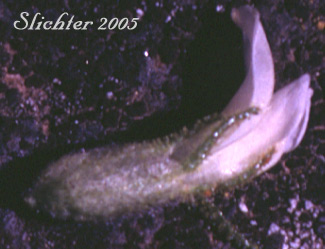 The
photo at right shows a close-up of the pinnately compound leaves of sticky crazyweed
as seen along the Hurricane Creek Trail, Eagle Cap Wilderness of northeastern
Oregon........June 26, 2004.
The
photo at right shows a close-up of the pinnately compound leaves of sticky crazyweed
as seen along the Hurricane Creek Trail, Eagle Cap Wilderness of northeastern
Oregon........June 26, 2004.
Sticky crazyweed is a tufted perennial wildflower with very short stems and numerous basal leaves arising from a woody base atop a stout taproot. The leaves, stems and calyx are typically fairly well covered by long, weak, spreading hairs or are covered by wartlike glands. The pinnately compound leaves 5-25 cm long with the petioles ranging from shorter to longer than the blades. The 25-41 ovate, lance-oblong or narrowly elliptic leaflets have obtuse to acute tips and are arranged nearly opposite from each other to clearly alternate along the central rachis. Individual leaflets measure 4-20 mm long and 1.5-4.5 mm wide.
The flower stems are equal to up to twice as long as the highest leaves and are topped by a sparsely flowered to dense spike-like raceme of 6-20 flowers. The bracts subtending each calyx are narrowly ovate to linear-lanceolate in outline and 4-11 mm long. The short, bell-shaped to slightly tubular calyx is 4.5-5.5 mm long and bears 5 awl-shaped teeth of varying length from 2-4 mm long. The outer surface of the calyx is sparsely to densely covered with long spreading to ascending hairs which are whitish to blackish in color and tipped with glands. The corolla is typically whitish or occasionally whitish-yellow, light lilac or vivid red-purple with the keel often purple at the tip. The banner measures 11-16 mm long with the slightly shorter wings about 2-3.5 mm wide at their broadest point near their tip. The ascending pods are sessile, lance-acuminate in outline and taper gradually to an elongated beak which may be gently deflected to the side. The pods measure from 14-22 mm long and 4-6 mm wide and bear a number of sticky glands on their surface.
Sticky crazyweed may typically be found in montane and submontane habitats, commonly occurring on talus or rocky and grassy areas on ridgetops and peaks. It may also be found amongst pines and aspen in open forests at lower elevations. This species is most common between the elevations of 1550-3660 meters.
Sticky crazyweed may be found in montane or tundra habitats from Alaska east to Quebec (Gaspe Peninsula) and southward to the Olympic Mts. of Clallam County in northwestern Washington and the Wallowa Mts. of northeastern Oregon. It is also found in the Sierra Nevada and White Mts. of California. In the Rocky Mts it is found southward to central Colorado. In the Great Basin, populations may be found in the Toiyabe and East Humboldt Ranges of central and northeaster Nevada and on the plateaus of central Utah (to the south of Salt Lake).
